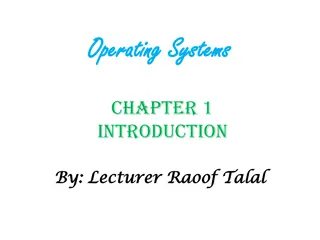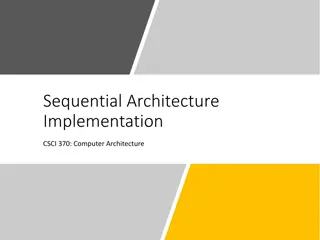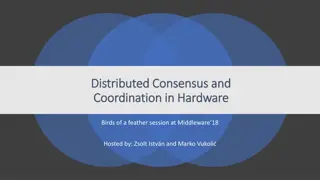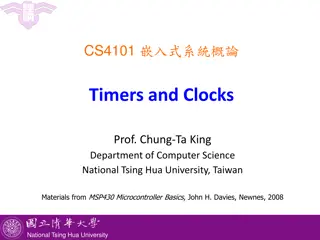Understanding Computer Organization and Architecture
A computer system is a programmable digital electronics device that processes data as per program instructions to provide meaningful output. It comprises hardware and software components, with hardware being the physical parts and software essential for driving the hardware. Computer organization fo
14 views • 71 slides
Addressing Monitoring Challenges in Hardware Offloading
Exploring the complexities of offloading monitoring tasks in hardware, this content delves into the limitations of current methods such as move_pages and IBS/PEBs-based monitoring. It highlights the need for efficient tracking mechanisms like IDLE-bit and proposes innovative solutions like Transpare
3 views • 17 slides
Hold Down and Release Mechanism Hardware Simulator for Ground Deployment Testing
The project involves developing a hardware simulator for testing a Hold Down and Release Mechanism used in Mars Sample Return missions. The simulator aims to replicate the functionality of expensive flight hardware at a lower cost and with reduced lead time. Key requirements include precise activati
3 views • 8 slides
Stainless Steel D Rings, O Rings & Weldable D Ring Hardware
Explore our collection of high-quality stainless steel D rings, weldable D rings, and versatile O rings. Ideal for various hardware applications, our rings ensure durability and reliability. Shop now at Buckles International for premium hardware rings.
0 views • 9 slides
Overview of Computer Hardware Components and Software Functions
Computer hardware components such as monitor, CPU, mouse, and projector are essential physical parts of a computer system, while software includes intangible programs like operating systems and utility software. Hardware components perform tasks like displaying data, processing information, and prin
8 views • 9 slides
Understanding Computer Systems: Components and Organization
Computer systems are high-speed electronic machines that process data and instructions through hardware and software components. The elements include hardware, software, and users, with binary systems using bits and bytes to represent data. The organization of a computer involves input, CPU, memory,
2 views • 21 slides
Understanding Operating Systems: Introduction and Functions
An operating system plays a crucial role in managing computer hardware and facilitating user-computer interactions. It serves as an intermediary between users and hardware components, ensuring efficient resource allocation and control. The operating system coordinates the use of hardware resources b
5 views • 16 slides
Interactive Timers for Engaging PowerPoint Sessions
Enhance your PowerPoint presentations with a variety of visual timers to help maintain an appropriate pace and keep your audience engaged. These timers come in different styles and durations, such as 45 seconds, 2 minutes, 5 minutes, and more. Easily integrate these timers into your slides to add a
0 views • 14 slides
Diploma in Hardware & Networking: Upgrade Your IT Skills
This course provides comprehensive knowledge and practical experience in computer hardware and networking, essential for managing IT infrastructure. Gain expertise in PC hardware maintenance, customer and networking support, and more to pursue a career as a Hardware and Network Engineer. Learn to as
1 views • 8 slides
Understanding Computer Systems and Components
Computer systems are high-speed electronic machines that process data and instructions to solve problems. They consist of hardware and software elements, with input and output devices for interaction. Key concepts include binary system, byte measurement units, hardware organization, and input hardwa
1 views • 21 slides
Efficient Data Race Detection Using Transactional Memory
This presentation discusses data race detection in multithreaded programs, exploring the impact of race conditions and the state-of-the-art dynamic data race detector solutions. It introduces a hybrid software and hardware approach leveraging Hardware Transactional Memory for lightweight data race d
1 views • 31 slides
Anatomy of a Computer System: Hardware Components and Functions
A typical computer system consists of hardware and software working together to perform various computational tasks. The hardware components include the central processing unit (CPU), input/output devices, storage units, and the motherboard. The CPU acts as the main brain of the computer, performing
6 views • 6 slides
Understanding Computer Hardware Components
Computer hardware encompasses the physical components of a computer system that can be touched and felt, such as the motherboard, CPU, RAM, and storage devices like HDD and SSD. Without hardware, essential software cannot run efficiently. This lesson explores the definition, importance, and various
1 views • 6 slides
Understanding the Basics of BIOS in Computers
BIOS (Basic Input Output System) is a crucial piece of software that serves as an intermediary between a computer's hardware and the operating system. It plays a fundamental role in facilitating communication and interaction between the hardware components and software applications. This article del
1 views • 26 slides
Understanding Timers and Interrupts in Operating Systems
This content discusses the importance of timers and interrupts in operating systems, focusing on how they facilitate preemptive multitasking. It covers how hardware timer interrupts help in preemption of processes by the kernel, ensuring efficient task scheduling and resource management in modern op
4 views • 18 slides
HIGHWIND Hardware: Team and Responsibilities Overview
Explore the team and responsibilities behind the HIGHWIND hardware project, involving airplane components, sensors, actuators, communication interfaces, control software, and visualization. Meet the dedicated members working on flight software and hardware, all focused on enhancing communication, sa
1 views • 31 slides
Optimizing DNN Pruning for Hardware Efficiency
Customizing deep neural network (DNN) pruning to maximize hardware parallelism can significantly reduce storage and computation costs. Techniques such as weight pruning, node pruning, and utilizing specific hardware types like GPUs are explored to enhance performance. However, drawbacks like increas
0 views • 27 slides
Overview of Electronics Maintenance and Pre-Processing Hardware at Agata Project - October 2016
The Agata Project in October 2016 involved maintenance and hardware updates on electronics components. It covered pre-processing electronics, hardware, and firmware maintenance, focusing on fuse sockets, bad contacts, and voltage supply issues. The project also included a mission report on installat
1 views • 7 slides
Hardware Monitoring Evolution at CERN: Lemon vs. Collectd
Comparison between Lemon and Collectd for hardware monitoring at CERN, detailing the differences, necessary changes, choices made, status update, current issues, and proposed fixes in transitioning from Lemon to Collectd. Collectd's advantages, drawbacks, and the adaptation process are discussed, hi
0 views • 19 slides
Overview of Fly and Trajectory Scans in Data Acquisition
Fly and trajectory scans in data acquisition involve software and hardware options for acquiring data while positioners move at constant speeds. Software fly scans enable periodic data acquisition triggered by software, while hardware fly scans rely on pulses from positioners. Hardware fly choices a
0 views • 14 slides
Introduction to Software Defined Radio (SDR) by Sandesh K.A.
Software Defined Radio (SDR) is a transformative technology where software modules run on flexible hardware platforms to implement radio functions. This introduction covers SDR basics, reasons for its adoption, hardware requirements, SDR architecture, available hardware options, and software used ac
0 views • 24 slides
Hardware Security and Trusted Platform Module Overview
This content discusses the importance of hardware security, distinguishing it from software security, and introduces the concept of Trusted Platform Module (TPM) as a trusted co-processor integrated into the platform to enhance security. It also highlights the role of the Trusted Computing Group (TC
0 views • 19 slides
Creative PowerPoint Timers for Effective Presentations
Enhance your PowerPoint presentations with these creative timers! Copy and paste timers of various durations to your slides, then customize their placement. During your slideshow, the timers will fade at the specified times, adding a dynamic element to your presentation. Explore more teaching and le
0 views • 4 slides
Understanding Hardware Design Languages in Advanced Computer Architecture
This material covers topics like behavioral correctness, timing simulations, domains, and levels of modeling in hardware design languages. It discusses functional and structural modeling, as well as the use of simulators to analyze and verify system behavior. Hardware Design Languages, behavioral de
0 views • 38 slides
Understanding Y86-64 Instruction Set and Hardware Control Language
Delve into the Y86-64 instruction set architecture, exploring sequential architecture implementations for computer architecture. Uncover the various instruction sets and their functionalities, such as halt, nop, call, ret, and more. Additionally, discover the building blocks of hardware, including A
0 views • 51 slides
Android Background Tasks: Notifications, Timers, Alarms, and Location Tracking
Learn how to create notifications, schedule tasks, set timers, use alarms, and track location in the background on Android. This comprehensive guide covers NotificationManager, Handlers, AlarmReceiver, and IntentServices for performing tasks efficiently without constant user interaction.
0 views • 8 slides
Understanding Interrupts and Timers in Microcontrollers
Microprocessors function as finite state machines, with instructions loaded from memory and executed in sequence. However, interrupts allow for urgent out-of-turn servicing of signals, providing a way to handle asynchronous events. Learn how to utilize interrupts efficiently with examples on Arduino
0 views • 9 slides
Embedded Systems Lab 10: Timer and Interrupt
This lab focuses on learning about timers and interrupts in embedded systems using MQX at National Tsing Hua University. It covers creating timer components, starting timers, and provides examples on simulating the control of an LED using timers. The content includes code snippets and explanations r
0 views • 15 slides
Understanding Timers and Time Tracking in Embedded Systems
Explore the importance of timers in embedded systems for tracking time, managing interrupts, and ensuring accurate timekeeping. Learn about different peripherals used, such as real-time clocks and processor timers, to handle tasks like updating UI elements, triggering alarms, and measuring intervals
0 views • 24 slides
Understanding Timers and Scheduled Interrupts in Physics 124
The lecture covers timer basics for Arduino Uno/Nano, discussing available timers, prescaler options, PWM frequencies, and implementation details. It explains prescaling and frequency concepts, wrap times for Timer0, Timer1, and Timer2, and the importance of timed interrupts for creating a schedule
0 views • 21 slides
Understanding Computer Architecture Interrupts and Exceptions
Computer architecture interrupts and exceptions are essential for handling external events and unexpected conditions during program execution. Interrupts are caused by external events such as I/O requests, timers, or hardware failures, while exceptions occur due to specific instruction executions. W
0 views • 19 slides
Architectural Hardware Support for Operating Systems in ECE344 Lecture
The lecture discusses the importance of hardware support in operating systems, emphasizing the management of hardware resources and providing a clear interface to programs. It explores the fundamental relationship between operating system functionality and hardware, highlighting how hardware support
0 views • 53 slides
Distributed Consensus and Coordination in Hardware Birds of a Feather Session
Specialists in distributed consensus and hardware coordination gathered at Middleware 18 for a session hosted by Zsolt István and Marko Vukoli. The session covered topics such as specialized hardware, programmable switches and NICs, P4 language for expressing forwarding rules, and deployment exampl
0 views • 33 slides
Understanding Virtualization: Hardware Abstraction and Hypervisor Concepts
Dive into the world of virtualization with a focus on hardware abstraction and hypervisor technology. Explore the definitions and examples of hardware virtualization, hypervisors, and hardware abstraction, shedding light on how they enable multiple operating systems to coexist on a single physical m
0 views • 21 slides
Understanding Operating Systems: An Introduction and Overview
An operating system is a crucial program that manages computer hardware and serves as an intermediary between users and hardware. This chapter explores the role of operating systems in a computer system, covering components like hardware, application programs, and users. It delves into how operating
0 views • 16 slides
Hardware-Assisted Page Walks for Virtualized Systems
Virtualization in cloud computing and server consolidation relies on hardware-assisted page walks for address translation in virtualized systems. This involves two-level address translations to ensure isolated address spaces for each virtual machine, utilizing multi-level page tables to manage memor
0 views • 32 slides
Approximate Computing in Hardware Design: A Comprehensive Overview
Explore the groundbreaking concepts of approximate computing in hardware design, which involves embracing errors to enhance resource efficiency and performance. Delve into topics such as avoiding worst-case design, criteria for approximate HDL, safety in hardware, and relaxing accuracy requirements
0 views • 31 slides
Embedded Systems: Timers, Clocks, and Real-Time Control
Explore the role of timers and clocks in embedded systems, covering topics such as real-time monitoring, time-based control, and challenges with software delay loops. Learn about using hardware counters for time references and integrating timers as I/O devices in clock systems.
0 views • 48 slides
Understanding Time Management in Embedded Systems
Explore the significance of time monitoring in embedded systems through examples like container thermometers and real-time applications. Learn about managing time-based controls, challenges with software delay loops, and the importance of hardware timers for accurate time tracking.
0 views • 47 slides
Understanding TCP Timers and Timer Wheels
Explore the purpose-built TCP timers designed by Dave Barach for fd.io Foundation. Delve into the two-level wheel algorithm with a timer granularity of 100ms, capable of handling up to 20 million concurrent timers. Learn about the timer wheels' operation, APIs for starting, stopping, and processing
0 views • 11 slides





































